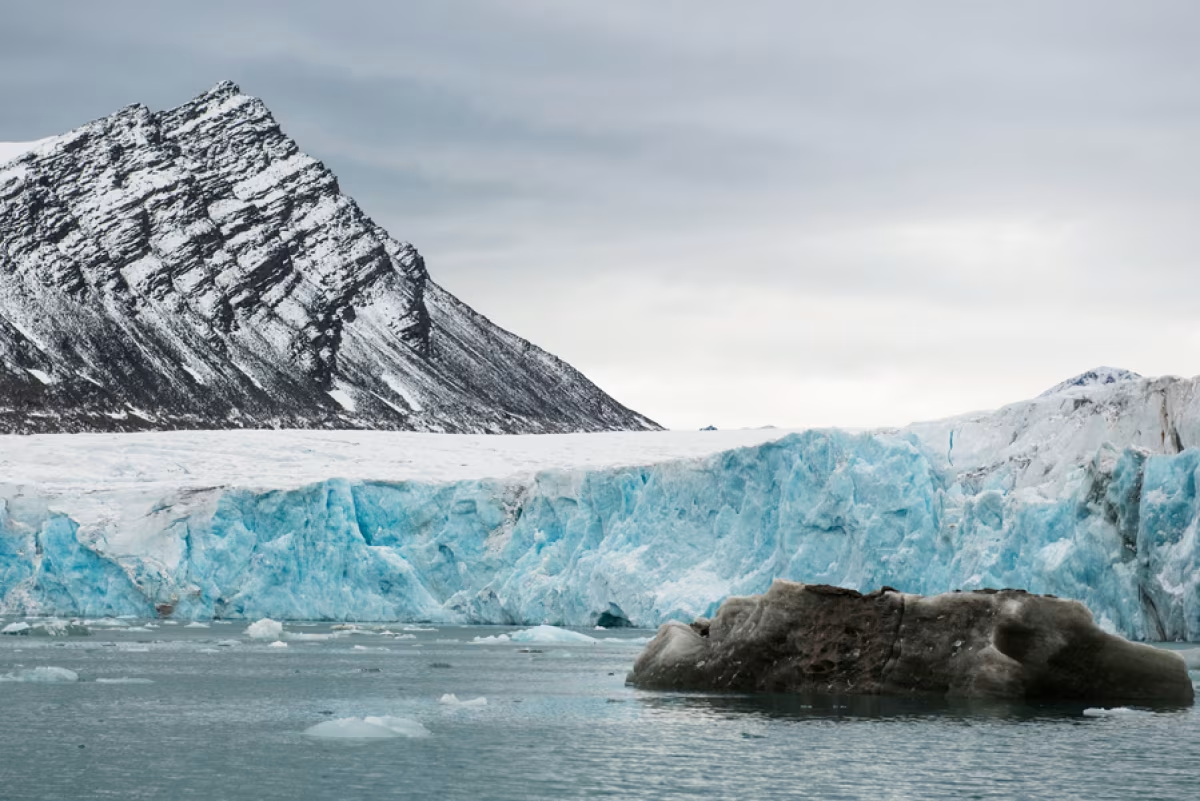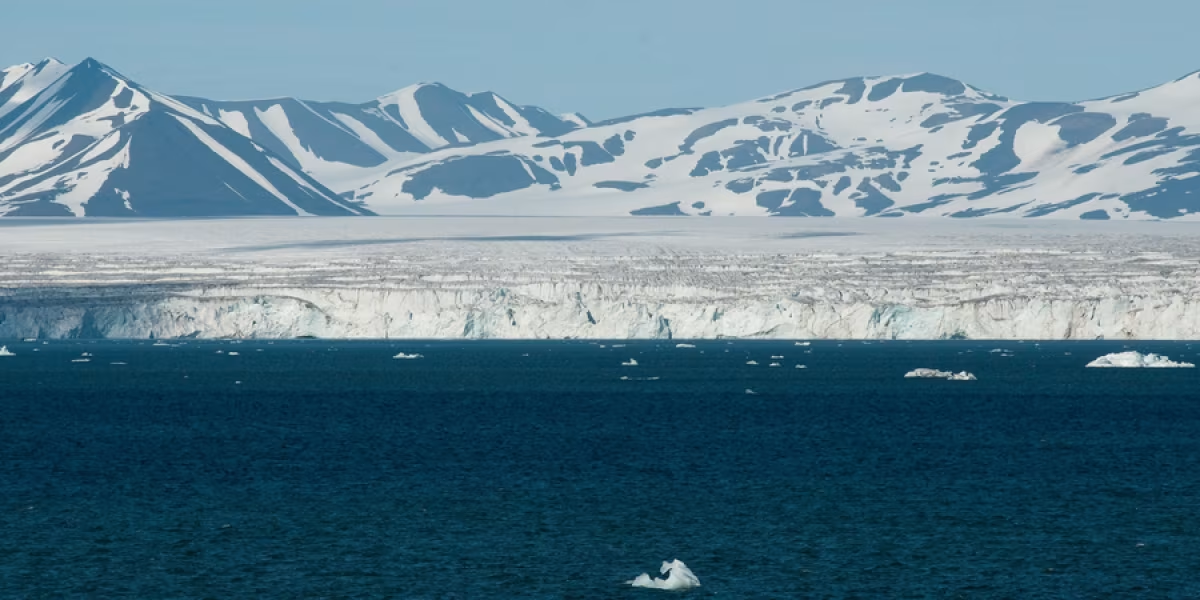Glaciers: essential Arctic and Antarctic attractions
One of the greatest natural sights you’ll ever see on an Arctic or Antarctic adventure is glaciers. These gigantic bodies of ice have been slowly but steadily creeping their way from the mountains to the oceans for countless years, like great rivers of ice – both a time capsule and indicator of our rapidly changing environment.

What is a glacier, and what types of glaciers are there?
A glacier is a huge mass of ice moving slowly from high ground to the sea. Glaciers are classified based on what stage of their journey they are at. As they travel from mountain peak to the ocean, they are given different names. Cirque glaciers are found up in the mountain peaks. As these glaciers move down into a valley, they become valley glaciers or alpine glaciers. When they reach the sea, they become known as tidewater glaciers. Tidewater glaciers are where icebergs originate. When these glaciers meet the sea, the water warms them slightly. This causes their ends to break off, or calve. The calved pieces become icebergs.

Glaciers vs. icebergs
These two terms are often used interchangeably, but glaciers and icebergs are two very different things. A glacier is positioned on land, entirely above the waterline. An iceberg is mostly underwater, with only a small percentage of the ice block above the surface. Glaciers are also kilometres/miles long and lead inland, whereas icebergs are smaller independent chunks that migrate around the polar regions of the ocean.

Pressure and time: how glaciers form
Glaciers are formed on high ground, in the troughs of hills and mountains. Over centuries, persistent snowfall accumulates in these troughs, builds up, and compresses. As the snow compresses, it becomes heavy, solid ice. When the compressed snow has built up enough weight, the giant body of ice dislodges. Gravity guides the ice downhill, and it is now a glacier. As the glacier starts to move downhill, continuing snowfall builds up behind it. This proceeds to compress into ice and feed the glacier, forming a continuous flow of ice. This is one of many glacier facts that can be seen during an Arctic or Antarctic cruise, though these regions produce different types of glaciers.

Glaciers on the move
The largest glaciers can weigh up to tens of millions of tons, so how do they move? The sides and base of the glacier, which are in contact with the Earth, are slightly warmer than the glacier’s top surface and core. This warmth causes a layer of water to form, which acts as a lubricant enabling the glacier to slide. The same effect happens if an ice cube is left on a table: As the ice cube melts, it slides freely across the table’s surface and become harder to pick up. If the glacier starts to melt at the front, it will appear to creep back up the mountain. This is known as glacial retreat. If the glacier grows, it is known as glacial advance.

Changing the landscape one glacier at a time
A glacier is a colossal force of nature. Although they tend to move slowly, glaciers leave significant changes on the landscape. As glaciers move downhill, they carve out valleys by way of friction and freeze-thaw. Freeze-thaw is a process whereby the meltwater of glaciers surrounds the neighbouring rocks and freezes again. The rocks then become attached to the glaciers. When the glaciers move, they break or pluck the rocks away. These rocks further aid in the erosion glaciers cause. The valleys left behind by glaciers are known as U-shaped valleys, as they have straight sides and flat floors.

Glamorous glacier colors
The top of a glacier appears white, whereas from the side it is blue. The snow and ice have been compressing over a longer period of time, and this makes the ice is dense. As light travels through the ice, it’s density slows down the white light from the atmosphere, and the ice appears blue (this is known as refraction). The fresher areas of the glacier will be white - these are the newer areas where the snow is not as densely compressed. Light bounces off these white crystalline regions, making them appear bright and sparkling. The color of a glacier will tell you how old it is - the older the glacier, the bluer it will appear.

Where glaciers are found
Nearly all the world’s glaciers are found in the polar regions, which is why they are one of main attractions of Antarctica trips as well as voyages to the Arctic. But glaciers can also be found in Argentina, Peru, China, India, and New Zealand. In the northern hemisphere, Greenland is known for its abundant glaciers, such as the Eqi Glacier. Greenland is mostly covered in a giant ice sheet, and glaciers are easily accessible. Vatnajökull Glacier in Iceland is another well-known glacier in the northern hemisphere, and it is one of the largest in Europe.
The best place to see glaciers, however, is in Antarctica. Deception Island in the South Shetlands, for example, is over 50% covered in glaciers. The island was previously a whaling station, but now it is an active spot for scientists and tourists. Elephant Island, at the northeast tip of the Antarctic Peninsula, is home to the well-known Endurance Glacier, and is famed as the island on which Ernest Shackleton and his crew were stranded for four and a half months in 1916.

Setting foot on a glacier
Many glaciers are solid enough to be walked on. There are many organised trips for people to visit, walk on, and even climb glaciers. Ice climbing on glaciers has become a popular activity for adventurous travellers. Accompanied by an experienced guide, you will be equipt with ice picks and crampons (spiked shoes) to help you climb up and down the glacier. Be careful, though: Crevasses, or vertical cracks in the ice, can be quite deep. Some extend all the way to the glacier base. Walking along the side of a glacier can often be more dangerous, as ice can break off and fall unexpectedly. The area where a glacier meets the sea is the most active area, as this is the point where large chunks of ice will calve off to form icebergs.

Five final glacier facts
1. Scientists who study glaciers are known as glaciologists. By examining the behaviour of glaciers and taking core samples from the ice, they can study changes in the environment.
2. Glaciers make up the largest reservoir of fresh water on the planet.
3. Living bacteria and microbes have been found in ice samples over 750,000 years old. To put that in perspective, modern humans have been around for about 40,000 years.
4. The bodies of unlucky explorers are sometimes found in the meltwater areas of glaciers. Recently the remains of a Swedish couple who went missing 75 years ago were found in the Tsanfleuron Glacier, in the western Bernese Alps.
5. There is strong evidence of glaciers on Mars. By studying the topography of the Martian surface, scientists believe they have identified the characteristic scars that glaciers leave behind as they move across the landscape.

Want to know more about glaciers?
Though this entry is meant to cover only basic glacier facts, such as what a glacier is and what types of glaciers there are, you can find more facts about glaciers at our website. Our article Glaciers and Icebergs of the Arctic and Antarctica, for example, explores not only the difference between glaciers and icebergs but also how these ice formations vary between poles. You can even read about specific glaciers, such as the 14th of July Glacier and Jakobshavn Glacier.






